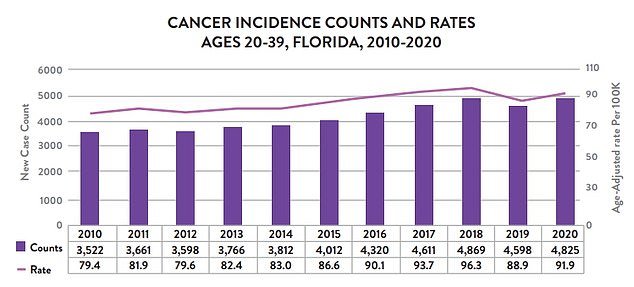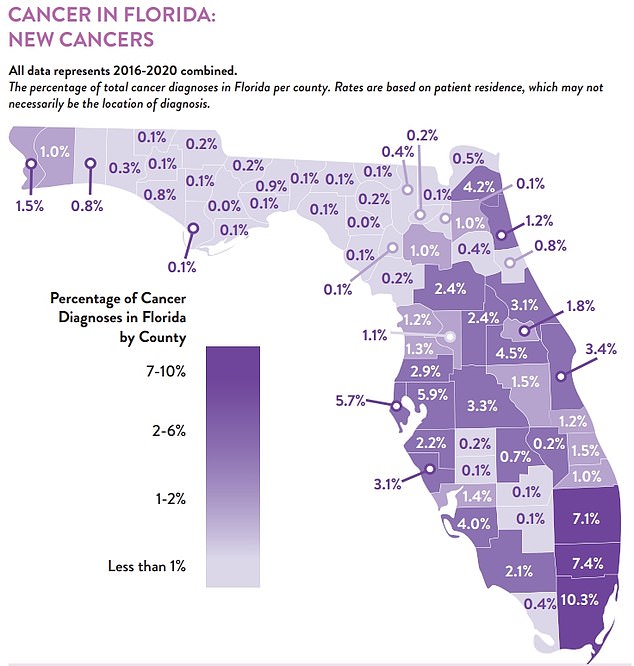Spike in premature cancers in young people in Florida sparks alarm as doctors warn ‘getting cancer in your 20s or 30s is now THE NORM’
Health officials in Florida have expressed concern about a sharp rise in cancer rates among young people.
Figures from the Florida Cancer Connect Collaborative show that rates for all cancer diagnoses increased 15 percent among people in their 20s and 30s between 2010 and 2020 — three times faster than the national average.
The figures rose faster in women than men, with doctors warning that patients were being diagnosed at later stages when their disease was more advanced and harder to treat.
Researchers can’t explain the increase, but modern diets, antibiotic use and yeast infections have all been cited as factors — but that wouldn’t explain why Florida’s numbers are rising so quickly.

Florida’s cancer rate among people ages 20 to 39 increased 15 percent in the decade between 2010 and 2020

The above map shows the percentage of cancer diagnoses by county in Florida. It highlights that the Miami area has the highest rates
Breast cancer was most common among younger adults and was the leading cause of cancer death, with colon cancer and leukemia among the most rapidly increasing.
Dr. Mohamedtaki Tejani, an oncologist at AdventHealth Cancer Institute, shared Orlando Sentinel: ‘Having people in their 20s and 30s (with cancer) was rare, and now it’s the norm.
“And what’s really sad is that younger patients tend to present with more advanced disease because it’s not on their radar.
‘It’s not on the radar of their GPs.’
Data shows that the diagnosis rate for all cancers among people ages 20 to 39 in Florida in 2010 was 79.4 cases per 100,000 people.
But this has increased by around two percent every year since 2010. In 2020, the number of cases was 91.9 per 100,000 people.
Among women under 50, the number of diagnoses of all forms of cancer rose from 118.6 to 131.5 in the same period – or an increase of 11 percent.
But for men under 50, the report found the rate remained stable at around 80 per 100,000 people.
The most common form of cancer among people in their 20s and 30s was breast cancer, with 6,966 cases diagnosed between 2010 and 2020.
This form of cancer was also the leading cause of cancer deaths among people in this age group, after 768 deaths.
The next four cancers with the highest cases were thyroid cancer (6,103 cases), skin melanoma (3,615), testicular cancer (2,922) and non-Hodgkin’s lymphoma (2,774).
However, the cancers that caused the most deaths differed from the cancers with the highest number of cases.
Between 2010 and 2020, leukemia, or blood cancer, was the second leading cause of death among young adults, causing 583 deaths. It was followed by brain cancer (509 deaths), colon cancer (499) and cervical cancer (399).
Florida First Lady Casey DeSantis, 43, founded the Florida Cancer Connect Collaborative earlier this year to collect and analyze cancer data and identify trends in the state to improve treatments.
The organization collects data from the state’s cancer incidence database, which relies on data provided by hospitals.

Pictured above is Casey DeSantis with her husband Ron as she talks about her battle with breast cancer
Ms. DeSantis, who herself battled breast cancer in 2021, wrote in the report: “Cancer can happen to anyone and is often unexpected.
“If you or a loved one are going through the process of battling this terrible disease, it is an emotional and overwhelming time.”
Ms. DeSantis entered remission in March 2022 after treatment with chemotherapy, radiation and three surgeries.
The increase in cancer rates among people ages 20 to 39 in Florida reflects a trend being recorded nationally.
In the US, cancer diagnoses for all types of the disease rose from 86 cases per 100,000 adults in this age group in 2010 to 89.6 cases per 100,000 in 2019.
The figure fell to 82.7 in 2020, according to the latest available data, although this was likely due to the Covid pandemic, which led to fewer diagnoses as many people missed check-ups, avoided medical facilities and doctors’ appointments were cancelled.
Of particular concern is colon cancer, which is often only discovered at a late stage – when it is much more difficult to treat.
Among adults aged between 20 and 30, the rate of bowel cancer rose from 4.8 to 6.2 cases per 100,000 in the ten years to 2020 – or an increase of 30 percent.
The death rate also increased slightly from 1.0 to 1.1 per 100,000, according to data from the Centers for Disease Control and Prevention (CDC).
But a study published in JAMA in 2021, it was estimated that bowel cancer would be the leading cause of death in people aged 20 to 49 within just seven years.
While doctors are still investigating why the number of colon cancer cases is increasing, they suspect it stems from overuse of antibiotics and fungal infections in the intestines.
Overuse of antibiotics can cause the disease as it can lead to an imbalance of microbes in the intestines, increasing the chance that dangerous bacteria or fungi will take root and damage cells.
As for the increasing rates of other cancers across the country, dOctors are baffled but suggest this could be due to a more sedentary lifestyle, Western diets and alcohol consumption.
